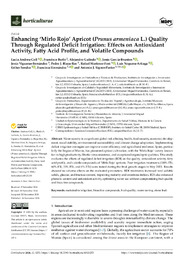Título :
Enhancing ‘Mirlo Rojo’ Apricot (Prunus armeniaca L.) Quality Through Regulated Deficit Irrigation: Effects on Antioxidant Activity, Fatty Acid Profile, and Volatile Compounds |
Autor :
Andreu Coll, Lucía 
Burló, Francisco 
Galindo, Alejandro
GARCIA BRUNTON, JESUS 
Vigueras-Fernández, Jesús
Blaya-Ros, Pedro José 
Martinez, Rafael
Noguera-Artiaga, Luis
Sendra, Esther 
Hernández García, Francisca
Signes-Pastor, Antonio Jose  |
Editor :
MDPI |
Departamento:
Departamentos de la UMH::Producción Vegetal y Microbiología |
Fecha de publicación:
2024-11-26 |
URI :
https://hdl.handle.net/11000/37067 |
Resumen :
Water scarcity is a significant global risk affecting health, food security, economic development, social stability, environmental sustainability, and climate change adaptation. Implementing deficit irrigation strategies can improve water efficiency and agricultural resilience. Spain, particularly the Region of Murcia, has pioneered apricot cultivation, with the ‘Mirlo Rojo’ variety known for its high productivity, Sharka virus resistance, and exceptional organoleptic qualities. This study evaluates the effects of regulated deficit irrigation (RDI) on the quality, antioxidant activity, fatty acid profile, and volatile compounds of ‘Mirlo Rojo’ apricots. Four irrigation treatments (100% ETc, 60% ETc, 33% ETc, and 0% ETc) were tested during the final growth stages in May 2023. Results showed no adverse effects on the evaluated parameters. RDI treatments increased total soluble solids, glucose, and fructose content, improving maturity and sweetness indices. RDI also enhanced phenolic content and antioxidant activity, optimizing water use without compromising fruit quality and bioactive compounds
|
Palabras clave/Materias:
Sustainable irrigation
Bioactive compounds
Fruit quality
Water saving
Stone fruit |
Tipo de documento :
info:eu-repo/semantics/article |
Derechos de acceso:
info:eu-repo/semantics/openAccess
Attribution-NonCommercial-NoDerivatives 4.0 Internacional |
DOI :
https://doi.org/10.3390/horticulturae10121253 |
Publicado en:
Horticulturae 2024, 10(12), 1253 |
Aparece en las colecciones:
Artículos - Producción vegetal y microbiología
|
 La licencia se describe como: Atribución-NonComercial-NoDerivada 4.0 Internacional.
La licencia se describe como: Atribución-NonComercial-NoDerivada 4.0 Internacional.
.png)
